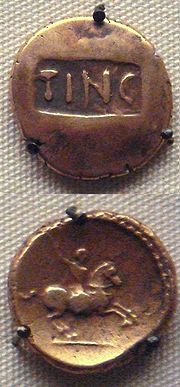
Tincomarus
Encyclopedia

Iron Age
The Iron Age is the archaeological period generally occurring after the Bronze Age, marked by the prevalent use of iron. The early period of the age is characterized by the widespread use of iron or steel. The adoption of such material coincided with other changes in society, including differing...
Belgic
Belgae
The Belgae were a group of tribes living in northern Gaul, on the west bank of the Rhine, in the 3rd century BC, and later also in Britain, and possibly even Ireland...
tribe of the Atrebates
Atrebates
The Atrebates were a Belgic tribe of Gaul and Britain before the Roman conquests.- Name of the tribe :Cognate with Old Irish aittrebaid meaning 'inhabitant', Atrebates comes from proto-Celtic *ad-treb-a-t-es, 'inhabitants'. The Celtic root is treb- 'building', 'home' The Atrebates (singular...
who lived in southern central Britain
Prehistoric Britain
For the purposes of this article, Prehistoric Britain is that period of time between the first arrival of humans on the land mass now known as Great Britain and the start of recorded British history...
shortly before the Roman invasion. His name was previously reconstructed as Tincommius, based on abbreviated coin legends and a damaged mention in Augustus
Augustus
Augustus ;23 September 63 BC – 19 August AD 14) is considered the first emperor of the Roman Empire, which he ruled alone from 27 BC until his death in 14 AD.The dates of his rule are contemporary dates; Augustus lived under two calendars, the Roman Republican until 45 BC, and the Julian...
's Res Gestae
Res Gestae Divi Augusti
Res Gestae Divi Augusti, is the funerary inscription of the first Roman emperor, Augustus, giving a first-person record of his life and accomplishments. The Res Gestae is especially significant because it gives an insight into the image Augustus portrayed to the Roman people...
, but since 1996 coins have been discovered which give his full name.
He was the son and heir of Commius
Commius
Commius was a historical king of the Belgic nation of the Atrebates, initially in Gaul, then in Britain, in the 1st century BC.-Ally of Caesar:...
and succeeded his father around 25-20 BC. Based on coin distribution it is possible that Tincomarus ruled in collaboration with his father for the last few years of Commius's life. Little is known of his reign although numismatic evidence suggests that he was more sympathetic to Rome than his father was in later years: the coins he issued much more closely resemble Roman types, and are so much better made that they must have come from professional Roman die-cutters. GC Boon has suggested that this technical advance was not limited to coinage and represents wider industrial assistance from the Roman Empire. Tincomarus's successors used the term rex on their coins and this indicates that Tincomarus had begun the process of achieving client kingdom status with Rome (see Roman client kingdoms in Britain
Roman client kingdoms in Britain
The Roman client kingdoms in Britain were native tribes who chose to align themselves with the Roman Empire because they saw it as the best option for self-preservation or for protection from other hostile tribes...
).
John Creighton argues, based on the imagery used on his coins, that Tincomarus may have been brought up as an obses (diplomatic hostage) in Rome
Ancient Rome
Ancient Rome was a thriving civilization that grew on the Italian Peninsula as early as the 8th century BC. Located along the Mediterranean Sea and centered on the city of Rome, it expanded to one of the largest empires in the ancient world....
in the early years of Augustus's reign. He compares Tincomarus's coins to those of Juba II
Juba II
Juba II or Juba II of Numidia was a king of Numidia and then later moved to Mauretania. His first wife was Cleopatra Selene II, daughter to Greek Ptolemaic Queen Cleopatra VII of Egypt and Roman triumvir Mark Antony.-Early life:Juba II was a prince of Berber descent from North Africa...
of Numidia
Numidia
Numidia was an ancient Berber kingdom in part of present-day Eastern Algeria and Western Tunisia in North Africa. It is known today as the Chawi-land, the land of the Chawi people , the direct descendants of the historical Numidians or the Massyles The kingdom began as a sovereign state and later...
, who is known to have been an obses, and identifies a coin found in Numidia which may bear the name of Tincomarus's younger brother Verica
Verica
Verica was a British client king of the Roman Empire in the years preceding the Claudian invasion of 43 AD.From his coinage, he appears to have been king of the Atrebates tribe and a son of Commius. He succeeded his elder brother Eppillus as king in about 15 AD, reigning at Calleva Atrebatum,...
.
By 16 BC Roman pottery and other imports appear in considerable quantities at Tincomarus's capital of Calleva Atrebatum, today known as Silchester
Silchester
Silchester is a village and civil parish about north of Basingstoke in Hampshire. It is adjacent to the county boundary with Berkshire and about south-west of Reading....
, and it is likely that the Atrebatic king had established trading and diplomatic links with Augustus.
Tincomarus was expelled by his subjects for unknown reasons around AD 8 and fled to Rome as a refugee and supplicant. He was replaced by his brother Eppillus
Eppillus
Eppillus was the name of a Roman client king of the Atrebates tribe of the British Iron Age. He was the son of Commius, the Gaulish former ally of Julius Caesar who fled to Britain following the uprising of Vercingetorix, or possibly of his son.After Commius's death in about 20 BC, based on...
whom Augustus chose to recognise as rex rather than depose and reinstate Tincomarus. Augustus may have planned to use his ally's ejection as an excuse to invade Britain but other, more pressing foreign policy matters probably persuaded him to postpone the move.

